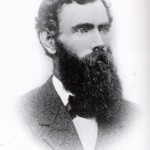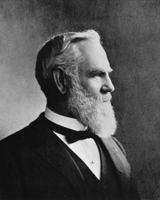 James Miller Guinn (aka J.M. Guinn), was a prominent educator and historian in southern California during the late 19th and early 20th centuries.
James Miller Guinn (aka J.M. Guinn), was a prominent educator and historian in southern California during the late 19th and early 20th centuries.
Guinn maintained an active role in his community, having membership in several local historical and fraternal societies, and kept lifelong affiliations with the Presbyterian Church and the Republican Party.
By the end of his life, Guinn had produced a voluminous literature on California and its prominent residents.
Born in Houston, Ohio, on Nov. 27, 1834, Guinn grew up working on his family’s farm, garnering his primary education during the winter school sessions. He became a teacher at eighteen years old, a vocation he utilized to earn his way through college – first at Antioch, and later at Oberlin.
When the news of the fall of Fort Sumter reached Guinn at Oberlin in 1861, he immediately volunteered to fight for the Union Army, serving as a member of Company C of the Seventh Ohio Infantry. He participated in the early West Virginia campaign, serving under Rosecrans, then later under McClellan. During this campaign, Guinn’s company saw heavy combat in the battles of Green Lane, Winchester, Cedar Mountain, Antietam, and Gettysburg.
At Cedar Mountain, Guinn was only one of six soldiers from his unit to emerge unhurt. After Gettysburg, his superiors promoted Guinn to corporal and sent his regiment to serve under William Tecumseh Sherman in the Tennessee and Georgia campaigns. During this service, Guinn again saw fighting at the battles of Lookout Mountain, Mission Ridge, and Ringgold. He mustered out in June 1864.
In poor health after leaving the army, Guinn traveled to California by way of Panama. Shortly after settling and finding a teaching position in Alameda County, however, Guinn got wind of gold finds in Idaho and walked three hundred miles to the Boise Basin to seek his fortune.
After failing to strike it rich after three years of mining, Guinn returned to California, this time to the southern portion of the state. In 1869, he reached the town of Anaheim with $10. (By the time he leaves Anaheim 12 years later, he will own $15,000 in land holdings.)
Guinn’s timing was perfect, and most certainly beneficial to Anaheim’s future educational system. Anaheim’s first teacher Fred William Kuelp had resigned due to ill health and his replacement, Carl Van Gulpen, is shortly replaced by Guinn.
Anaheim had been established 10 years prior to Guinn’s arrival, and educating their children was a top priority of the German colonist.
Unlike the Spanish Pobladores (colonists), who always built a church first and left the building of a school house to those who came after them, the Anaheim Colonists built the school house first and left the church building to those who came later.
An adobe building was erected in 1860, to serve the double purpose of a school house and assembly hall, on a lot in the center of the colony. But during the great flood of 1861-62, the waters of the Santa Ana River over damaged the foundation of the school house, rendering the building unsafe.
While classes continue in the Water Company’s building on Center Street, Anaheim formed an official school district in 1867, then finally erected a new school building in 1869. This is when Guinn stepped in to begin his 12-year reign as the Anaheim School District’s first principal.
In 1870, Guinn listed an enrollment of 91 students, divided into two schools (primary and grammar) and taught by two teachers. The town’s population at this time is estimated at 1,000.
This same year he helped form, along with W.W. McFadden, newly elected Superintendent of Los Angeles Schools, the first teachers’ institute of LA County. The men had also worked together to form a LA County Board of Education as a means to standardize county schools. (Anaheim schools fell under the jurisdiction of the LA Board of Education, as Orange County wasn’t founded until March 11, 1889.)
Much of the time that Guinn was in Anaheim, he was a member of the School Board and took an active interest in examining teachers who applied for certificates (the legal licensing procedure at that time).
In 1871, a report by McFadden showed 20 school districts in Los Angeles County, as compared to the six it had in 1855. Among them, he showed Anaheim with two schools (the primary and grammar departments) with 204 students. This first grade was taught by Guinn, who held a State Educational Diploma and earned $90-per-month salary.
High standards were being set by Guinn. The school staged its first exhibit with a program of declamations, dialogues, farces, tableaux and music. By charging a fee for this first open house, Guinn purchased charts and an outline map for the school. He also established the first final examination dates, which included an oral exam that was open to the public.
By 1874, Guinn, who is both principal and teacher, is offering subjects for high school diploma and begins classifying students into grades. The high school curriculum included classes in history, physiology, natural philosophy, rhetoric, algebra, geometry, trigonometry, geology, astronomy, chemistry, philosophy, botany and zoology.
This is also the year Guinn marries a young teacher in the Anaheim schools, Dapsiliea Marquis. The marriage produced three children: daughters Mabel Elizabeth and Edna Marquis, and son Howard James.
In ensuing years, the school building became inadequate for the growing population. In 1877, a plot of land is purchased for a new school building at the cost of $1,500, and Professor Guinn drafts a bill authorizing the district to issue bonds to the amount of $10,000.
He was instrumental in securing its passage by the legislature. It became a law March 12, 1878. The bonds were sold at par and the school building, costing more than $10,000, was built out of the proceeds. This was one of the first, if not the first, instance in the state of incorporating and bonding a school district to secure funds to build a school house – a method that since has become quite common and has given to California the best district school houses of any state in the Union.
Anaheim school district was extended to take in what was formerly Fairview district and a four-room school house in West Anaheim.
 1879 – The new two-story Central School opens on January 16. The school, which features as clock steeple and bell tower, is built in the center of a two-acre lot at 231 Chartres Street. The 217 elementary through high school students are taught by two men and two women who are paid $75 a month.
1879 – The new two-story Central School opens on January 16. The school, which features as clock steeple and bell tower, is built in the center of a two-acre lot at 231 Chartres Street. The 217 elementary through high school students are taught by two men and two women who are paid $75 a month.
1880 – Matilda Rimpau, daughter of Anaheim pioneer Theodore Rimpau, is the first student in the Anaheim school system to graduate with a high school diploma.
Also in 1880, Thompson & West’s History of Los Angeles County says: “The town of Anaheim boasts of the handsomest school building and the largest school in the county outside of Los Angeles city.”
 In 1881, after Anaheim schools showed marked improvement, the city of Los Angeles hired Guinn to superintend their school system. After two years in this position, Guinn shifted his vocational interests into real estate and merchandising, although he maintained a strong interest in Los Angeles’ history and educational facilities for the remainder of his life. He also served as deputy county assessor for several years.
In 1881, after Anaheim schools showed marked improvement, the city of Los Angeles hired Guinn to superintend their school system. After two years in this position, Guinn shifted his vocational interests into real estate and merchandising, although he maintained a strong interest in Los Angeles’ history and educational facilities for the remainder of his life. He also served as deputy county assessor for several years.
Politically he was a stanch Republican. He was secretary of a Republican club before he was old enough to vote, and, arriving at the voting age, he cast his first vote for John C. Fremont in 1856 and voted for every Republican nominee for President.
In 1873, when the county was overwhelmingly Democratic, he was the Republican nominee for the assembly and came within 52 votes of being elected. In 1875, he was the nominee of the anti-monopoly wing of the Republican party for state superintendent of public instruction. For the sake of party harmony, he withdrew just before the election in favor of the late Professor Ezra Carr, who was triumphantly elected.
Guinn served a number of years on the Republican county central committee, being secretary from 1884 to 1886, and he was a long time (and founding) member of the Stanton Post (Los Angeles) chapter of the Grand Army of the Republic.
He was a member of the American Historical Association, a founding member of the Historical Society of Southern California, and filled every office in the society. He was an officer in the Pioneers of Los Angeles County, served on the LA Board of Education between 1904 and 1914, and received a gubernatorial appointment to serve on the California Historical Commission in 1914.
As an historian, Guinn became very prolific toward the end of his life, producing a number of massive volumes on several California counties and notable residents. He also wrote a brief history of California, and a history of Los Angeles city and county. He contributed a number of valuable historical papers to magazines and newspapers and edited the SoCal Historical Society’s Annual for 10 years.
He was a member of the American Historical Association of Washington, D.C., having the honor of being the only representative of that association in Southern California. While in the teaching profession, he was a frequent contributor to educational periodicals and ranked high as a lecturer on educational subjects before teachers’ institutes and associations.
Guinn died at his home in Highland Park after a short illness in September 1918, weeks shy of his eighty-fourth birthday.
From the description of History of the Stanton Post 8055 G.A.R., [1890?]. (Natural History Museum Foundation, Los Angeles County). WorldCat record id: 23250333 and the description of Papers of James Miller Guinn, 1824-1918 (bulk 1870-1918). (Huntington Library, Art Collections & Botanical Gardens). WorldCat record id: 299167713.




